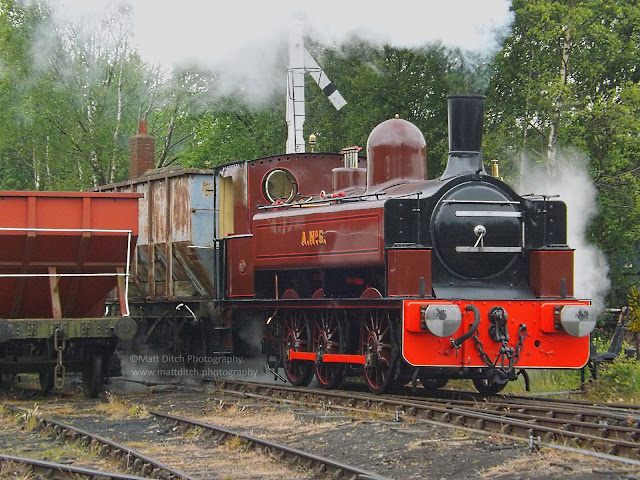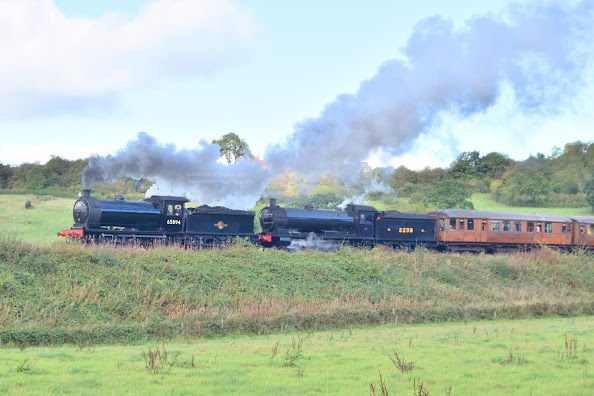Railways around Chopwell
Railways around Chopwell
Chopwell and Garesfield Railway
The Chopwell and Garesfield Railway was opened in 1899 by the Consett Iron Co LTD, although some parts of the railway date back to earlier waggonways. The railway carried coal from Chopwell Colliery and High Spen/Garesfield Colliery(Bute Pit) to Derwenthaugh Coke works (built 1928) and onto Derwenthaugh staithes on the River Tyne. Today the section of trackbed through the woods is called the “Old Colliery Railway Footpath”, which is where the following pictures were taken.
A short section of track has been relayed on the former trackbed and a pair of 21 ton wagons placed on top of it. The wagon closest to the camera is painted in National Coal Board livery and the furthest is painted in Consett Iron Co Livery, to reflect the two owners of the railway. These are located a short distance from the main car park.
This wood carving depicts one of the Kitson long boiler 0-6-0 Pannier tanks that used to work the line. This is one of several sculptures located around the woods. Lucky “A.No.5” was preserved at the nearby North Tyneside Railway. The below picture was taken during its visit to the Tanfield Railway and shows what a train on the line would have looked like. Sadly A.No.5 is now out of service requiring a new boiler.
Located a short walk from the wagons is the “Stoney Road Bridge” the bridge is the last of its type in the area and was built in 1884 the carry the “Stoney Road” over the railway. At one time the road was the main route between Rowlands Gill and Chopwell. It finally closed to traffic in 2002. The railway finally closed in 1961.
Whittonstall railway
Victoria Garesfield Colliery
The second standard gauge railway within Chopwell Woods was the 1.5 mile line to Victoria Garesfield Colliery. This line came off the North Eastern Railways “Consett Branch” just before Rowlands Gill station. It was at Rowlands Gill where there was a modest sized exchange sidings. From here the line passed the Coke Ovens, these were the last “Beehive” coke ovens in the country. Thankfully a section of it survives as a monument. The railway then reached the colliery at Victoria Garesfield. It was here that there was a short tunnel which still survives today. On the other side of the tunnel was the location of the engine sheds. Several of the OS maps shows a line running from the engine shed to near Alexandra street.
The Tunnel as it is today, notice how the once bricked up entrance has had a hole smashed into it.
Looking into the tunnel. The cutting the tunnel opened out into has been filled in up to just below the hatch at the top of the arch. The Colliery was on the left-hand side of the tunnel.
Looking towards Rowlands Gill from the other side of the tunnel. As mentioned above the Colliery would have been on the left. As to be expected little trace of it remains. The Coke ovens were straight ahead from here.
Looking back out in the direction of the engine shed, which would have been dead ahead from here. Sadly there are no traces of it. From here we followed the course of the line towards Alexandra street and discovered a number of former “drift mine” entrances.
Victoria Garesfield Colliery - going underground
The first drift mine I came across was located behind the side of the old engine shed. At first glance you may not notice it was even there. But upon closer inspection you may notice the sections of Narrow gauge rail sticking out from the earth. There’s also the remains of the brick wing walls either side of the rails, and you can just make out the top of the brick arch and the wall above that.
The second drift entrance proved to be a little more accessible than the previous one, as the below image shows!
I believe this tunnel linked the main colliery with a number of other drift mines in the area, although I wasn’t prepared to climb in and find out! If this is the case then this would be looking in the direction of Victoria Garesfield Colliery.
The above two images show the exterior and interior of the third and finale drift mine entrance I found. Again this one was behind Alexandra street. If my above assumption is correct the line would have come from the colliery through the second tunnel across the edge of the valley and then into this mine.
A short distance away we also found what we are led to believe is an air shaft (pictured below).
Victoria Garesfield Colliery Tubway
The last point of interest for us is the short reinstated section of narrow gauge Tubway. Tubways are the name given to the railways within mines, the tubs been the name given to the wagons that run on them. The Victoria Garesfield tubway was one of several that ran underneath the woods. But a short section of it ran above ground in this gully. It was restored in the early 2000s by the friends of Chopwell woods. The restoration work included placing a short rake of restored “Tubs” on a small length of narrow gauge track completes with rollers and cable (see below image), which is how these wagons would have been moved along
For more information on Chopwell and the surrounding areas I’d highly recommend checking out the following websites: Victoria Garesfield History and Chopwell History. At some point in the future I would like to write some more in depth histories on these lines.






















Comments
Post a Comment